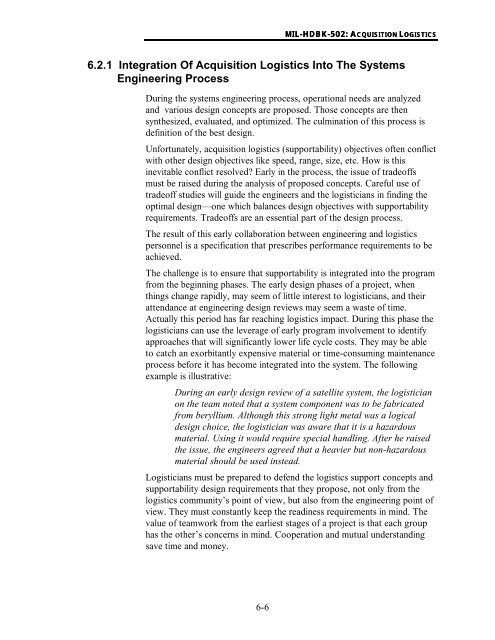MIL-HDBK-502 - Barringer and Associates, Inc.
MIL-HDBK-502 - Barringer and Associates, Inc.
MIL-HDBK-502 - Barringer and Associates, Inc.
Create successful ePaper yourself
Turn your PDF publications into a flip-book with our unique Google optimized e-Paper software.
<strong>MIL</strong>-<strong>HDBK</strong>-<strong>502</strong>: ACQUISITIONALOGISTICS6.2.1 Integration Of Acquisition Logistics Into The SystemsEngineering ProcessDuring the systems engineering process, operational needs are analyzed<strong>and</strong> various design concepts are proposed. Those concepts are thensynthesized, evaluated, <strong>and</strong> optimized. The culmination of this process isdefinition of the best design.Unfortunately, acquisition logistics (supportability) objectives often conflictwith other design objectives like speed, range, size, etc. How is thisinevitable conflict resolved? Early in the process, the issue of tradeoffsmust be raised during the analysis of proposed concepts. Careful use oftradeoff studies will guide the engineers <strong>and</strong> the logisticians in finding theoptimal design—one which balances design objectives with supportabilityrequirements. Tradeoffs are an essential part of the design process.The result of this early collaboration between engineering <strong>and</strong> logisticspersonnel is a specification that prescribes performance requirements to beachieved.The challenge is to ensure that supportability is integrated into the programfrom the beginning phases. The early design phases of a project, whenthings change rapidly, may seem of little interest to logisticians, <strong>and</strong> theirattendance at engineering design reviews may seem a waste of time.Actually this period has far reaching logistics impact. During this phase thelogisticians can use the leverage of early program involvement to identifyapproaches that will significantly lower life cycle costs. They may be ableto catch an exorbitantly expensive material or time-consuming maintenanceprocess before it has become integrated into the system. The followingexample is illustrative:During an early design review of a satellite system, the logisticianon the team noted that a system component was to be fabricatedfrom beryllium. Although this strong light metal was a logicaldesign choice, the logistician was aware that it is a hazardousmaterial. Using it would require special h<strong>and</strong>ling. After he raisedthe issue, the engineers agreed that a heavier but non-hazardousmaterial should be used instead.Logisticians must be prepared to defend the logistics support concepts <strong>and</strong>supportability design requirements that they propose, not only from thelogistics community’s point of view, but also from the engineering point ofview. They must constantly keep the readiness requirements in mind. Thevalue of teamwork from the earliest stages of a project is that each grouphas the other’s concerns in mind. Cooperation <strong>and</strong> mutual underst<strong>and</strong>ingsave time <strong>and</strong> money.6-6
















